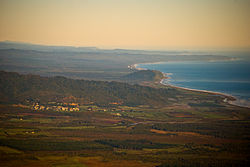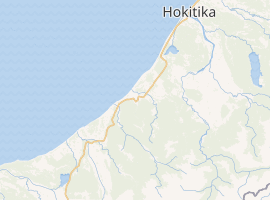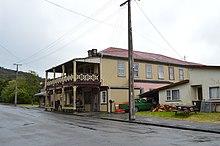Ross | |
|---|---|
 An aerial photograph of Ross, with the Tasman Sea seen to the right. | |
 | |
| Coordinates: 42°53′45″S 170°48′51″E / 42.89583°S 170.81417°E | |
| Country | New Zealand |
| Region | West Coast |
| District | Westland District |
| Ward | Northern |
| Electorates | West Coast-Tasman Te Tai Tonga |
| Population (2018 Census)[1] | |
| • Total | 285 |
| Time zone | UTC+12 (NZST) |
| • Summer (DST) | UTC+13 (NZDT) |
| Postcode | 7812 |
| Area code(s) | 03 |
| Local iwi | Ngāi Tahu |
Ross is a small town located in the Westland District on the West Coast of New Zealand's South Island. Lying 27 kilometres south-west of Hokitika and 46 kilometres north-east of Harihari, State Highway 6 passes through Ross on its route from Ruatapu south to Pukekura, Harihari, and further south, the Franz Josef Glacier.[2][3]
History
Ross was established in the 1860s, during the West Coast Gold Rush, where it became an important centre for miners.[4] At its largest, the town had around 2,500 inhabitants, but the population declined after local goldfields were depleted in the early 1870s.[5] Quartz was occasionally mined on Mount Greenland, a nearby ridge, but little more gold was found until two miners discovered a large 3.1-kilogram nugget in 1909, which was later named the "Honourable Roddy Nugget", after Roderick McKenzie, the Minister for Mines at the time.[6] A branch line railway known as the Ross Branch was extended from Ruatapu to Ross on 1 April 1909, serving as the southern terminus of the line owned by the New Zealand Railways Department. However, a lengthy privately owned bush tramway ran south from the railway station to serve logging interests near Lake Ianthe[7] and a railway extension from Ross through the Haast Pass to connect with the Otago Central Railway was proposed in the early 20th century, but did not eventuate.[8] From the 1940s until 9 October 1962, a Vulcan railcar service operated directly from Christchurch to Ross twice a day. A lack of traffic and expensive maintenance costs meant the line was closed beyond Hokitika on 24 November 1980. Much of the old track bed between Ruatapu and Hokitika can be driven as it serves as an access road for local farmers, and a disused truss bridge still stands north of Ross.[9]
Demographics
Ross is defined by Statistics New Zealand as a rural settlement and covers 8.71 km2 (3.36 sq mi). It is part of the wider Waitaha statistical area, which covers 1,499.99 km2 (579.15 sq mi).[10]
The population of Ross was 285 in the 2018 census, a decrease of 12 from 2013. There were 153 males and 132 females. 90.5% of people identified as European/Pākehā, 12.6% as Māori and 2.1% as Asian. 13.7% were under 15 years old, 8.4% were 15–29, 52.6% were 30–64, and 25.3% were 65 or older.[1]
| Year | Pop. | ±% p.a. |
|---|---|---|
| 2006 | 438 | — |
| 2013 | 471 | +1.04% |
| 2018 | 450 | −0.91% |
| Source: [11] | ||
Waitaha statistical area
The statistical area of Waitaha had a population of 450 at the 2018 New Zealand census, a decrease of 21 people (-4.5%) since the 2013 census, and an increase of 12 people (2.7%) since the 2006 census. There were 213 households. There were 246 males and 204 females, giving a sex ratio of 1.21 males per female. The median age was 51.7 years (compared with 37.4 years nationally), with 72 people (16.0%) aged under 15 years, 51 (11.3%) aged 15 to 29, 231 (51.3%) aged 30 to 64, and 99 (22.0%) aged 65 or older.
Ethnicities were 90.7% European/Pākehā, 14.7% Māori, 0.7% Pacific peoples, 2.0% Asian, and 4.0% other ethnicities (totals add to more than 100% since people could identify with multiple ethnicities).
The proportion of people born overseas was 10.0%, compared with 27.1% nationally.
Although some people objected to giving their religion, 58.7% had no religion, 30.7% were Christian and 3.3% had other religions.
Of those at least 15 years old, 39 (10.3%) people had a bachelor or higher degree, and 129 (34.1%) people had no formal qualifications. The median income was $24,300, compared with $31,800 nationally. The employment status of those at least 15 was that 195 (51.6%) people were employed full-time, 75 (19.8%) were part-time, and 12 (3.2%) were unemployed.[11]
Economy
The town's economy is based around farming and forestry, although a large open-cut mine has operated directly adjacent to the town since 1988.[12]
Education
Ross School, a coeducational contributing primary school with a roll of 26 students as of March 2020,[13] is located within the town.[14] The school opened in 1875[15] and celebrated its 125th anniversary in 2000.[16]
References
- ^ a b "Age and sex by ethnic group (grouped total response), for census usually resident population counts, 2006, 2013, and 2018 Censuses (urban rural areas)". Statistics New Zealand. Retrieved 11 February 2021.
- ^ Peter Dowling (editor) (2004). Reed New Zealand Atlas. Reed Books. map 68. ISBN 0-7900-0952-8.
- ^ Roger Smith, GeographX (2005). The Geographic Atlas of New Zealand. Robbie Burton. map 165. ISBN 1-877333-20-4.
- ^ Heritage Archived 5 February 2013 at the Wayback Machine – Ross Goldfields. Retrieved 18 June 2012.
- ^ Visitor information Archived 5 February 2013 at the Wayback Machine – Ross Goldfields. Retrieved 18 June 2012.
- ^ Ross, The West Coast, South Island, New Zealand – Visit New Zealand. Retrieved 18 June 2012.
- ^ Churchman & Hurst 2001, p. 193.
- ^ "The Dense Forests and Snow-Fed Streams of the West: Ross to Wanaka via the Haast Pass", Otago Witness (24 January 1906), 57.
- ^ David Leitch and Brian Scott, Exploring New Zealand's Ghost Railways, revised edition (Wellington: Grantham House, 1998 [1995]), 60-1.
- ^ "ArcGIS Web Application". statsnz.maps.arcgis.com. Retrieved 15 January 2021.
- ^ a b "Statistical area 1 dataset for 2018 Census". Statistics New Zealand. March 2020. Waitaha (311800). 2018 Census place summary: Waitaha
- ^ "Ross, West Coast". Te Ara: The Encyclopedia of New Zealand.
- ^ "New Zealand Schools Directory". New Zealand Ministry of Education. Retrieved 26 April 2020.
- ^ Education Counts: Ross School
- ^ "Untitled". West Coast Times. 28 August 1875. p. 2.
- ^ "Ross Remarks!" (PDF). Community Contact. May 2003.
Further reading
- Churchman, Geoffrey B; Hurst, Tony (2001) [1990, 1991]. The Railways of New Zealand: A Journey through History (Second ed.). Transpress New Zealand. ISBN 0-908876-20-3.
